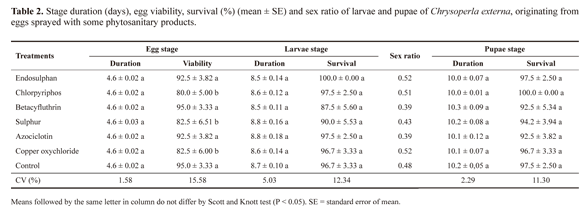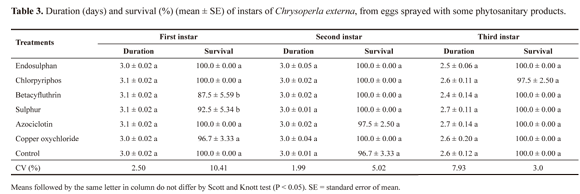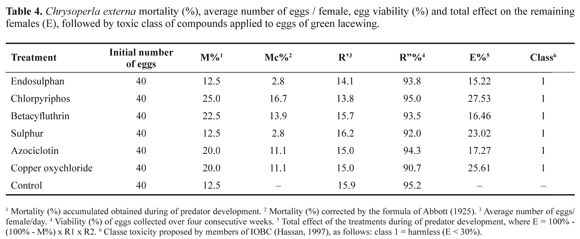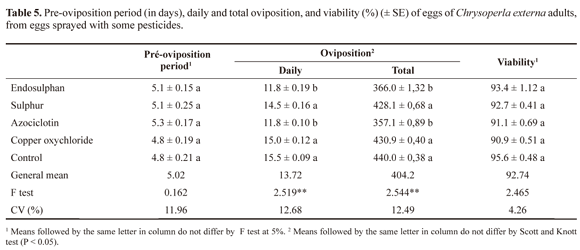Services on Demand
Journal
Article
Indicators
-
 Cited by SciELO
Cited by SciELO -
 Access statistics
Access statistics
Related links
-
 Cited by Google
Cited by Google -
 Similars in
SciELO
Similars in
SciELO -
 Similars in Google
Similars in Google
Share
Revista Colombiana de Entomología
Print version ISSN 0120-0488
Rev. Colomb. Entomol. vol.38 no.1 Bogotá Jan./June 2012
Effects of pesticides on eggs of Chrysoperla externa (Neuroptera: Chrysopidae) and consequences on subsequent development
Efectos de los plaguicidas en huevos de Chrysoperla externa (Neuroptera: Chrysopidae) y las consecuencias sobre su desarrollo
ROGÉRIO ANTÔNIO SILVA1, GERARDO ANDRADE CARVALHO2,3, CÉSAR FREIRE CARVALHO2,4 and DIEGO BASTOS SILVA2,5
1 Ph. D. Researcher in Entomology at the EPAMIG-URESM/EcoCentro Fellow of FAPEMIG, P.O. Box 176, Zip Code: 37200-000. Lavras, Minas Gérais, Brazil. rogeriosilva@epamig.ufla.br. Corresponding author.
2 Universidade Federal de Lavras (UFLA), Departamento de Entomologia, P.O. Box 3037, Zip Code: 37200-000. Lavras, Minas Gerais, Brazil.
3 Dr. in Entomology, Selectivity of pesticides for natural enemies.
4 Prof. Dr. in Entomology, Biology of Insects.
5 Doctorate student in Entomology.
Received: 9-aug-2011 - Accepted: 22-may-2012
Abstract: The effects of six pesticides applied to the coffee crop on eggs and their consequences on the subsequent developmental stages of Chrysoperla externa (Neuroptera: Chrysopidae) were evaluated under laboratory conditions. The pesticides and water (control) were sprayed on eggs using a Potter's tower. After spraying, forty eggs per treatment were individualized in glass tubes and maintained in a climatic chamber, in order to evaluate immature development of this predator. The treatments showed significant differences for egg viability and survival of first-instar larvae. Chlorpyrifos, sulphur and copper oxichlorate reduced the treated egg viability, whereas both sulphur and betacyfluthrin reduced the survival of first-instar larvae. Endosulphan and azociclotin reduced the daily oviposition of this green lacewing species. The harmless products (Class 1, E < 30%), can be recommended for use in integrated pest management programs in coffee crops, in order to preserve this predator.
Key words: Coffea arabica. Green lacewing. Pesticides. Selectivity.
Resumen: Los efectos de seis plaguicidas aplicados al cultivo de café sobre los huevos y etapas de desarrollo posteriores de Chrysoperla externa (Neuroptera: Chrysopidae), fueron evaluados bajo condiciones de laboratorio. Los plaguicidas y el agua (control) fueron aplicados en los huevos usando una torre de Potter. Después de la aplicación, cuarenta huevos por tratamiento fueron individualizados en tubos de vidrio y mantenidos en cámara bioclimática, con el objetivo de verificar las posibles anormalidades en el desarrollo de este depredador. Los tratamientos mostraron diferencias significativas para la viabilidad de los huevos y la supervivencia del primer instar larval. Chlorpyrifos, azufre y oxicloruro de cobre redujeron la viabilidad de los huevos tratados, mientras que el azufre y el betacyfluthrin redujeron la supervivencia del primer instar larval. Endosulfán y azociclotin redujo la oviposición diaria de esta especie crisopa. Los productos inocuos (Clase 1, E < 30%), pueden recomendarse para su uso en programas integrados de manejo de plagas en los cultivos de café, a fin de preservar este depredador.
Palabras clave: Coffea arabica. Crisopas. Plaguicidas. Selectividad.
Introduction
The coffee agroecosystem presents optimal conditions for the deployment of integrated control measures, because the perennial nature of the plants favors the increase of predators and parasitoids, which can reach levels capable of reducing arthropod pest populations (Altieri 1994). However, the indiscriminate use of pesticides on this crop has been drastically reducing the populations of beneficial insects (Micheletti 1991).
Insects of the family Chrysopidae (Neuroptera) have been reported as having high predatory capacity and adaptation to different ecosystems (Souza and Carvalho 2002; Costa et al. 2010). They have a high biotic potential, feeding on aphids, mealybugs, eggs, larvae and pupae of moths, eggs and adult mites, occurring naturally in coffee (Gravena 1992; Carvalho and Ciociola 1996).
Natural biological control by lacewings is among the most important integrated pest management (IPM) tactics for population regulation of the coffee leaf miner Leucoptera coffeella (Guérin-Méneville & Perrottet, 1842) (Lepidoptera: Lyonetiidae), the coffee ring spot mite Brevipalpus phoenicis (Geijskes, 1939) (Acari: Tenuipalpidae) and the coffee red mite Oligonychus ilicis (McGregor, 1917) (Acari: Tetranychidae). Preference should be given to the use of selective pesticides, namely, those that control the coffee pests without negatively affecting the natural enemy populations (Gravena 1992). Thus, in order to control Hypothenemus hampei (Ferrari, 1867) L. coffeella and Planococcus minor (Maskell, 1897), this study evaluated the effects of pesticides used in coffee, on eggs of C. externa and their consequences on the subsequent stages of development.
Materials and Methods
Tests of physiological selectivity were carried out in accordance with the methodology recommended by the "International Organization for Biological Control of Noxious Animals and Plants" (IOBC), West Palearctic Regional Section (WPRS) (IOBC/WPRS 1992; Hassan 1997; Carvalho et al. 2002).
Lacewing adults were collected in a citrus orchard at the Universidade Federal de Lavras (UFLA), taken to the laboratory for identification of species and reared the laboratory. Fourth generation C. externa eggs, approximately 12 hours old, were removed from the laboratory rearing cages by cutting the pedicels with the aid of fine-tipped scissors and placed into seven groups of 40, in 15 cm diameter Petri dishes.
We evaluated some of the products most used on coffee crops to control pests and diseases, which were applied in the higher concentrations, recommended by the manufacturers, and water application as control. The products, with their respective technical names, trade names and chemical group are presented in table 1.
The products were sprayed directly on the eggs with a Potter's tower at a regulated pressure of 15 lb/pol2 with an applied chemical spray volume of 1.5 ± 0.5 mL/cm2. After application of the compound, the dishes were kept in the laboratory for two hours to reduce egg surface moisture and then were individualized in glass tubes (2.5 cm in diameter and 8.5 cm in height), sealed with PVC film and kept in a climatic chamber at 25 ± 2°C, RH 70 ± 10% and 12 hour of photophase. After hatching, the larvae were fed ad libitum every two days with Anagasta kuehniella (Zeller, 1879) (Lepidoptera: Pyralidae) until pupation.
The experimental design utilized was a completely randomized design with seven treatments and ten repetitions with four eggs per plot. The eggs were individualized in tubes because cannibalism by newly hatched larvae is a common problem in green lacewing egg studies (Costa et al. 2003; Bezerra et al. 2009). For evaluation of larvae, pupae and adult six replications were conducted. We evaluated the egg stage duration and egg viability, duration and larval survival of the first, second and third instars and pupae. The adult sex ratio and fertility were evaluated for a period of four consecutive weeks from the beginning of oviposition.
To evaluate fertility of lacewings reared from sprayed eggs, pupae from each treatment were kept in glass tubes until adult emergence. Adults were allocated to groups comprised of six mating pairs (12 lacewings) per cylindrical PVC cage (10 cm height and 10 cm in diameter). Each cage was lined with filter paper, supported on a tray covered with the same kind of paper, and its top sealed with muslin. The adults were fed a diet of brewer's yeast and honey (1:1 v/v), brushed on a porous material (sponge) set on the end of an 8 ml glass tube containing distilled water, kept on top of each cage according to the methodology of Barbosa et al. (2002).
During three consecutive weeks from the beginning of oviposition, the number of eggs on the paper was checked and removed every four days. Additionally, 96 eggs were separated per treatment, which were individualized into micro titer plate compartments used in the ELISA test (Enzyme Linked Immunosorbent Assay). Plates were closed with sheets laminated with PVC and kept under the same environmental conditions described above.
The data from the embryonic, larval, pupae, pre-oviposition, oviposition and pos-reproductive periods, egg viability, larvae and pupae survival were subjected to analysis of variance, the means being grouped by the Scott and Knott test at 5% significance (Scott and Knott 1974). The total effect (E) of each product was assessed in terms of mortality and reproductive aspects during the development of the predator, by the formula E = 100% - (100% - M%) x R1 x R2, proposed by Vogt (1992), where E = total effect (%) M = mortality (%) accumulated from the egg stage until adult emergence in each treatment corrected by the formula of Abbott (1925), where R1 = ratio between the average daily eggs laid per female from the treatment with the product compared to the control and R2 = ratio between the average survival rate of eggs laid per female originated from the treatment with the product compared to control. After obtaining the total effect (E), each formulation was framed in toxicity classes proposed by the IOBC (Hassan 1997), as follows: class 1 = harmless (E < 30%), class 2 = slightly harmful (30 < E < 79%), class 3 = moderately harmful (80 < E < 99%) and class 4 = harmful (E > 99%).
Results and Discussion
The duration of the egg stage was not affected by any of the treatments (F = 0.01; df = 6; P = 1.00), with an average of developmental time of 4.6 days for eggs from all treatments (Table 2). This result differ from those obtained by Carvalho et al. (2002), who observed an increase in the embryonic period when they used endosulfan at a dose of 1.05 g a.i./liter of water, applied on eggs of C. externa. This difference may be due to application methodology, Carvalho et al. (2002) used a sprayer adjusted to deliver a volume of 1.7 ± 0.5 ml/cm2, which was higher than the volume used in our research.
Egg viability was significantly reduced by chlorpyrifos, sulfur and copper oxychloride (F = 1.96; df = 6; P = 0.048), with viability means of 80.0%; 82.5% and 82.5%, respectively, compared with endosulfan, azociclotin, betacyfluthrin and control, which showed averages of the 92.5%; 92.5%; 95.0% and 95.0%, respectively (Table 2). Even with significant differences, egg viability in all treatments was high, similar to studies of Grafton-Cardwell and Hoy (1985), who reported that egg and pupa stages of lacewings are the most tolerant to phytosanitary products.
These results are also similar to that obtained by Godoy et al. (2004), who applied the pyrethroid deltamethrin at a dosage of 0.0125 g a.i./liter of water and had mean of 76.7% for egg viability of C. externa. They are also in agreement with observations of Carvalho et al. (1998) who used growth regulator products, they found viabilities of eggs ranging from 76.6% to 96.6%, and those of Carvalho et al. (2002) who applied endosulfan, esfenvalerate, fenpropathrin, trichlorfon and triflumuron in eggs of C. externa and found egg viability from 73.3% to 90%.
Viability of eggs treated with the acaricide azociclotin, was 92.5%, similar result to that obtained by Mattioli et al. (1992), who used the acaricide fembutatina oxide on eggs of Ceraeochrysa cubana (Hagen, 1861) (Neuroptera: Chrysopidae) and observed a viability of 86.8%. For treatment with sulfur, the viability was 82.5%, confirming results obtained by Moraes and Carvalho (1993) who applied sulfur at the same dosage on the eggs of C. cubana.
The duration of the larval period and survival of larvae were not affected by the products and the averages ranged from 8.5 to 8.8 days (F = 0.85; df = 6; P = 0.538) and 87.5% to 100.0% (F = 1.50; df = 6; P = 0.192), respectively (Table 2). The products betacyfluthrin and sulfur were responsible for lower survival of first instar larvae, with averages of 87.5% and 92.5%, respectively, differing significantly from the other treatments, including the control (100%) survival (F = 2.40; df = 6; P = 0.037) (Table 3). This may have occurred because this compound has a high residual action, and thus, some larvae when hatched were contaminated by their residues in the chorion (Godoy et al. 2004). However, it did not affect the duration of this instar (F = 7.14; df = 6; P = 0.072). These results resemble those of Godoy et al. (2004) who, by applying deltamethrin in eggs of C. externa, at a dosage of 0.0125 g a.i. / liter of water, found a significant decrease on first instar larval survival.
The second instar larvae were not affected by the treatments, with an average duration of three days and survival rate of 96.7% for the control; 97.5% for azociclotin and 100.0% for the other treatments (F = 0.01; df = 6; P = 1.00) (Table 3). The same occurred for the duration of the third instar, where the average period ranged from 2.4 to 2.7 days and mean survival was 97.5% for chlorpyrifos, 100% for the other treatments and for the control 96.7%. Similar results were observed by Godoy et al. (2004), where fembutatine oxide was sprayed on C. externa eggs at a dose of 0.4 g a.i. / liter of water resulted in 95.0% and 90.0% survival for the second and third larval instars, respectively, and deltamethrin at 0.0125 g a.i. / liter of water, resulting in 100.0% of survival for the two larval instars.
For pupae originating from treated eggs, a toxic effect of products was not found (F = 2.09; df = 6; P = 0.066), showing duration of 10 to 10.3 days and survival ranging from 92.5% to 100.0% (Table 2).
The sex ratio of adult C. externa was not affected by the treatments (F = 0.68; df = 6; P = 0.659), and ranged from 0.39 to 0.52 (m:f) (Table 2). Although no significant differences occurred, treatments based on betacyfluthrin and azociclotin provided lower values for the sex ratio (> number of males) trends that were also observed by Godoy et al. (2004), when treating C. externa eggs with deltamethrin.
The products chlorpyrifos and betacyfluthrin presented mortality of 25.0 e 22.0% respectively. 20.0% of mortality was found for adults sprayed with azociclotin and copper oxychloride and only 12.5% of mortality for those treated with endosulfan, sulfur and the control (Table 4).
Taking into consideration the total effect (E) of the compounds on the development stages of C. externa, all compounds were classified as class 1 = harmless (E < 30%) (Table 4). Similar results were obtained by Carvalho et al. (2002), when spraying eggs of C. externa with endosulfan and also with pyrethroids esfenvalerate and fenpropathrin. Godoy et al. (2004), when evaluating the total effect (E) of deltamethrin applied on eggs of C. externa has framed this product as class 2 = slightly harmful (30 < E < 79%), disagreeing with the total effect (E) of the pyrethroid betacyflu-thrin that this work categorized as class 1. This disagreement, though small, may have been due to tolerance differences of C. externa to insecticides of the pyrethroid group, as reported by Grafton-Cardwell and Hoy (1985), which may have been evidenced in our work.
Evaluating the reproductive capacity of survival pairs of C. externa , it was found that the products used did not affect the pre-oviposition period, which ranged from 4.8 to 5.3 days (F = 0.162; df = 6; P = 0.096) (Table 5). These results are similar to those obtained by Figueira et al. (2002) who studied the biology of C. externa adult; they observed duration of 11.5 days for the pre-oviposition period of females fed with the same diet used in this study.
For the daily mean oviposition in the period evaluated it was observed that females of C. externa from eggs sprayed with endosulfan and azocyclotina showed lower daily oviposition, with an average of 11.8 eggs / female / day (F = 2.51; df = 6; P = 0.045) compared to those sprayed with sulfur, copper oxycloride and water (control), which presented means of 14.5, 15.0 and 15.5 eggs / female / day (F = 2.51; df = 6; P = 0.045) respectively (Table 5). These results were similar to Figueira et al. (2002), who obtained an average of 18.5 eggs/ female/day for adults of C. externa from no sprayed eggs and adults fed with the same diet.
Endosulfan and azocyclotine did not affect the adult survival, yet somehow influenced reproduction, reducing fecundity (F = 1.86; df = 6; P = 0.032). These results are similar to those of Ulhoa et al. (2002), who found a reduction in oviposition capacity of C. externa after application of triflumuron at a dose of 0.038g a.i. L-1 of water. Velloso et al. (1999) evaluated growth regulators insecticides on adults of the same green lacewing, they found that buprofezin, cyromazine and pyriproxifen did not affect neither the ability of oviposition nor egg viability, demonstrating that these compounds may act differently in the physiology of adults of this species, compared to the compound triflumuron evaluated by Ulhoa et al. (2002).
Egg viability was not affected by any product, with averages ranging from 90.7 to 95.2% (F = 2.46; df = 6; P = 1.00) (Table 4), being similar to the results of Figueira et al. (2002) who obtained 87.7% of viability for eggs of C. externa that received no spray and was fed with the same diet. Ribeiro et al. (1991) also observed similar viability (95.4%) for eggs of the same species, which has not received any spray and was fed with the same diet.
Conclusion
On the toxicity tests in the laboratory, the insects are subject to the maximum exposure to residues of the commercial formulations of pesticides. This is the first step of the sequence of tests recommended by the IOBC / WPRS (Hassan et al. 2000). According to classes of toxicity established by the IOBC / WPRS, the insecticide endosulfan (1.75 g/L), chlorpyriphos (1.20 g/L), betacyfluthrin (0.013 g/L), Sulfur (4.00 g/L), copper oxychloride (5.00 g/L) and azociclotin (0.31 g/L) were classified as class 1, selective to eggs of C. externa and do not affect the subsequent developmental stages. These products can be recommended for pest management programs in coffee growing in association with this predator seeking its preservation under natural conditions.
Acknowledgements
To the Research Support Foundation of Minas Gerais - FAPE-MIG for providing a PhD scholarship, and to the Federal University of Lavras - UFLA and Epamig-CTSM/EcoCentro for the lab support.
Literature cited
ABBOTT, W. S. 1925. A method of computing the effectiveness of an insecticide. Journal of Economic Entomology 18: 265-267. [ Links ]
ALTIERI, M. A. 1994. Biodiversity and pest management in agroecosystems. New York: Food Products Press, 185 p. [ Links ]
BARBOSA, L. R.; FREITAS, S.; AUAD, A. M. 2002. Capacidade reprodutiva e viabilidade de ovos de Ceraeochrysa everes (Banks,1920) (Neuroptera: Chrysopidae) em diferentes condicöes de acasalamento. Ciencia e Agrotecnologia, Lavras 26 (3): 466-471. [ Links ]
BEZERRA, C. E. S.; NOGUEIRA, C. H. F.; SOMBRA, K. D. S.; DEMARTELARE, A. C. F.; ARAUJO, E. L. 2009. Crisopídeos (Neuroptera: Chrysopidae): Aspectos biológicos, potencial de utilizacäo e perspectivas futuras. Revista Caatinga, Mossoró 22 (3): 01-05. [ Links ]
CARVALHO, C. F.; CIOCIOLA, A. I. 1996. Desenvolvimento, utilizacäo e potencial de Neuroptera: Chrysopidae para controle biológico na América Latina. pp. 294-303. In: Simposio de Controle Biológico, Foz do Iguacu. Anais. Curitiba: Sincobiol. [ Links ]
CARVALHO, G. A. CARVALHO, C. F.; OLIVEIRA, C. M. 1998. Efeito de reguladores de crescimento de insetos e do fungicida captan sobre ovos de Chrysoperla externa (Hagen) (Neuroptera: Chrysopidae). Ciencia e Agrotecnologia 22: 476-482. [ Links ]
CARVALHO, G. A.; CÉSAR F. CARVALHO; BRÍGIDA SOUZA; JOÄO L.R. ULHÖA. 2002. Seletividade de inseticidas a Chrysoperla externa (Hagen) (Neuroptera: Chrysopidae). Neotropical Entomology, Londrina 31 (4): 615-621. [ Links ]
COSTA, R. I. F.; CARVALHO, C. F.; SOUZA, B.; LORETI, J. 2003. Influencia da densidade de individuos na criacäo de Chrysoperla externa (Hagen, 1861) (Neuroptera: Chrysopidae). Ciencia e Agrotecnologia, Lavras 27: 1539-1545. (Edicáo Especial). [ Links ]
COSTA, R. I. F.; SOUZA, B.; FREITAS, S. 2010. Dinámica espaco-temporal de taxocenoses de crisopídeos (Neuroptera: Chrysopidae) em ecossistemas naturais. Neotropical Entomology 39: 470-475. [ Links ]
FIGUEIRA, L. K.; CARVALHO, C. F.; SOUZA, B. 2002. Influencia da temperatura sobre alguns aspectos biológicos de Chrysoperla externa (Hagen, 1861) (Neuroptera: Chrysopidae) alimentada com ovos de Alabama argillacea (Hübner, 1818) (Lepidoptera: Noctuidade). Ciencia e Agrotecnologia, Lavras 26: 1439-1450. (Edicáo Especial). [ Links ]
GODOY, M. S.; CARVALHO, G. A.; MORAES, J. C.; GOUSSAIN, M. M.; MORAES, A. A.; COSME, L. V. 2004. Seletividade de inseticidas utilizados na cultura dos citros para ovos e larvas de Chrysoperla externa (Hagen, 1861) (Neuroptera: Chrysopidae). Neotropical Entomology 33 (3): 639-646. [ Links ]
GRAFTON-CARDWELL, E. E.; HOY, M. A. 1985. Short - term effects of permethrin and fenvalerate on oviposition by Chrysoperla carnea (Neuroptera: Chrysopidae). Journal of Economic Entomology 78 (4): 955-959. [ Links ]
GRAVENA, S. 1992. Manejo ecológico de pragas do cafeeiro. Jaboticabal: FUNEP, 30 p. [ Links ]
HASSAN, S. A. 1997. Métodos padronizados para testes de seletividade, com énfase em Trichogramma. pp. 207-233. In: Parra José R. P e Zucchi, Roberto A. (Eds.) Trichogramma e o controle biológico aplicado. Piracicaba. Brasil: FEALQ, 354 p. [ Links ]
HASSAN, S. A.; HALSALL, N.; GRAY, A. P.; KUEHNER, C.; MOLL, M.; BAKKER, F. M.; ROEMBKE, J.; YOUSEF, A.; NASR, F.; ABDELGADER, H. 2000. A laboratory method to evaluate the side effects of plant protection products on Trichogramma cacoeciae Marchal (Hym., Trichogrammatidae). pp. 107-119. In: Candolfi, M. P.; Blümel, S.; Forster, R.; Bakker, F. M.; Grimm, C.; Hassan, S. A.; Heimbach, U.; Mead-Briggs, M. A.; Reber, B.; Schmuck R.; Vogt, H. (Eds.). Guidelines to evaluate side effects of plant protection products to non-target arthropods. Montfavet: IOBC/WPRS. 158 p. [ Links ]
INTERNATIONAL ORGANIZATION FOR BIOLOGICAL AND CONTROL OF NOXIOUS ANIMALS AND PLANTS. West Palearctic Regional Section. 1992. Working Group "Pesticides and Beneficial Organisms", Guidelines for testing the effects of pesticides on beneficial organisms: description of test methods. Bulletin IOBC/WPRS 15: 1-186. [ Links ]
MATTIOLI, E.; CARVALHO, C. F; SALGADO, L. O. 1992. Efeitos de inseticidas e acaricidas sobre ovos, larvas e adultos do predador Ceraeochrysa cubana (Hagen, 1861) (Neuroptera: Chrysopidae) em laboratòrio. Ciencia e Pràtica 16: 491-497. [ Links ]
MICHELETTI, S. M. F. B. 1991. Efeito de inseticidas sobre a emergéncia de Trichogramma spp. (Hymenoptera: Trichogrammatidae). Anais Sociedade Entomológica do Brasil n. 20: 265-269. [ Links ]
MORAES, J. C.; CARVALHO, C. F. 1993. Seletividade de acaricidas a ovos, larvas e adultos de Ceraeochrysa cubana (Hagen, 1861) (Neuroptera: Chrysopidae). Ciencia e Pràtica 17: 388-392. [ Links ]
RIBEIRO, M. J.; CARVALHO; C. F.; MATIOLLI, J. C. 1991. Influencia da alimentacáo larval sobre a biologia dos adultos de Chrysoperla externa (Hagen, 1861) (Neuroptera: Chrysopidae). Ciencia Pràtica 15: 349-354. [ Links ]
SCOTT, A. J.; KNOTT, M. A. 1974. A cluster analyses method for grouping means in the analyses of variance. Biometrics 30: 502512. [ Links ]
SOUZA, B.; CARVALHO, C. F. 2002. Population dynamics and seasonal occurrence of adults of Chrysoperla externa (Hagen, 1861) (Neuroptera: Chrysopidae) in a citrus orchard in southern Brazil. Acta Zoologica Academiae Scientiarum Hungaricae (Suppl. 2) 48: 301-310. [ Links ]
ULHÖA, J. L. R.; CARVALHO, G. A.; CARVALHO, C. F. 2002. Acäo de inseticidas recomendados para o controle do curuquerédo-algodoeiro para pupas e adultos de Chrysoperla externa (Hagen, 1861) (Neuroptera: Chrysopidae). Ciencia e Agrotecnologia, Lavras 26: 1365-1372. (Edicáo Especial). [ Links ]
VELLOSO, A. H. P. P; RIGITANO, R. L.; CARVALHO, A. C; CARVALHO, E C. 1999. Efeitos de compostos reguladores de crescimento de insetos sobre larvas e adultos de Chrysoperla externa (Hagen, 1861) (Neuroptera: Chrysopidae). Ciencia e Agrotecnologia, Lavras 23 (1): 96-101. [ Links ]
VOGT, H. 1992. Untersuchungen zu nebenwirkungen von insektiziden und akariziden auf Chrysoperla carnea (Stephens) (Neuroptera: Chrysopidae). Mededelingen Rijksfaculteit Landbouw-wetenschappen te Gent 57: 559-567. [ Links ]


















